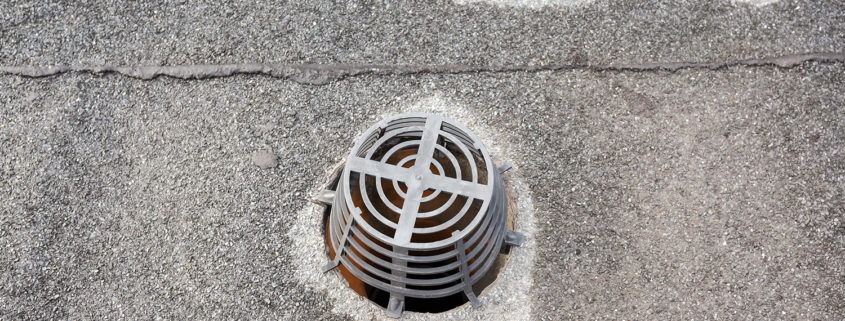Roof drains are an essential but often overlooked component of your commercial roof system. It’s easy to take your roof’s drains for granted when they’re working. But when they’re not functioning correctly from lack of regular roof drain maintenance, that’s usually when disaster strikes. How do you maintain your drainage system to avoid damage to your roof? Keep reading to find out!
Types of Roof Drainage Systems
The vast majority of commercial buildings have low-sloped or flat roofs. There are two main types of drain systems for flat roofs: gravity systems and siphonic systems. Commercial roofs can also be equipped with gutters and scuppers.
Gravity Drain
Gravity drains rely on gravity to move water from the roof to the ground since water always seeks the lowest level. A roof with a gravity-fed drain will usually have four sloping segments that will direct water to a single drain. Pipes have to be inclined so water flows downward to a vertical drain pipe.
Gravity drains are most appropriate for smaller commercial roofs, because larger roofs will collect water faster than this type of system can be drained.
Siphonic Drain
Large commercial roofs often employ a siphonic drain system. A baffle on each drain point prevents air from entering the pipes, which have lower atmospheric pressure than their outside environment. Water entering the drain encounters this area of low pressure and is pulled in faster than the force of gravity. Siphonic drains can drain at nearly 100 times the drainage speed of a gravity system.
In siphonic systems, pipes run straight until they connect to a vertical drain pipe that empties to the ground. This leaves more room for HVAC systems and other roof-mounted apparatuses.
Gutters
Gutters are most commonly found on residential pitched roofs rather than commercial roofs, but can still be paired with other drainage systems. Gutters run along the edge of the building and direct water to a downspout and then to the ground.
Scuppers
Scuppers are openings that are incorporated into the walls at the edge of the roof. They are usually about two inches above the roof surface, and typically only needed during times of heavy rain because they direct water down the side of the building.
Consequences of Blocked Roof Drains
Gravity and siphonic drain systems both incorporate measures to prevent clogs and backups. A gravity system has a strainer in place to prevent large pieces of material from entering the pipe. A siphonic system’s baffle will perform the same function as the strainer. Even though both of these devices protect pipes from clogs, they can both suffer from blockages if they aren’t inspected and cleaned regularly.
Roof drain cleaning should be part of the regular maintenance schedule of your commercial roof. Severe weather can deposit leaves and other debris onto your roof, eventually causing buildup around the drain or baffle.
When water can’t drain from your roof, ponding can occur. Ponding is standing water on your roof that can lead to more problems, such as fungus, plant growth, and degradation of your roofing materials. Water pooling on your roof can also attract birds and other wildlife.
Lack of drainage can also lead to disastrous water overflow, where water will get pushed to areas where it shouldn’t be. Whether you make it a DIY project or seek professional help, proper roof maintenance should always include a clean out of your drains.
Flat Roof Drain Inspection
Even if you have a professional inspection performed on your building’s roof, it’s a great idea to be familiar with all aspects of your roof and its drainage system. You should have your roof inspected and cleaned at least once a year. If your building has already suffered from roof or drainage issues, consider more frequent inspections. The end of autumn and beginning of summer are the best times to have your roof inspected and cleaned. At the end of autumn, all of the leaves have already fallen and the maximum amount can be cleaned from your roof. At the beginning of summer, volatile spring weather has passed and any debris that may have ended up on your roof from spring storms can be cleared.
Make sure that during your inspection, you or the commercial roofer that you employ performs the following tasks:
- First, all foreign debris and objects should be removed from the roof and around the drain or baffles. The strainer or baffles should be completely visible and securely fastened in place.
- Next, check for any ponding water. This could not just be a drainage issue, but a failure of the roofing materials causing the roof to sag.
- Then perform a test of the drainage speed to ensure that it drains adequately and there are no clogs. If your roof also has gutters, make sure that the gutters are clear and that the downspouts are directing water properly to the ground.
As part of your roof maintenance, also make sure that any trees near your roof are trimmed so leaves don’t fall directly on your roof where they can pile up. Consider doing this before your roof inspection so that any debris that may be left over from the tree trimming will be cleared during your roof cleaning.
Don’t Ignore Your Roof Drains
Roof drain maintenance is just a small part of the health of your commercial roof system, but it can have huge repercussions if overlooked. TEMA Roofing Services includes roof drain maintenance as part of our Roof Asset Management Service to prolong the lifespan of your commercial roof.
When it’s time to get your roof inspected, repaired, or replaced, contact a roofing contractor you trust. TEMA Roofing Services has decades of combined experience in the commercial roofing industry and can help you keep your commercial property maintained. Contact TEMA Roofing today!





